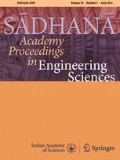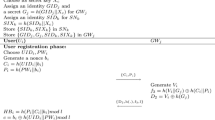Abstract
Underground coal mines are considered as one of the most dangerous workspaces as many hazardous factors regularly cause accidents. It may be avoided by real-time monitoring of environmental parameters (gas, temperature, the width of walls, etc.) of underground tunnels. Nowadays, wireless sensor network (WSN) is widely used for safety monitoring of coal mines. However, any kind of interception, modification and interruption of transmission of environmental parameters can mislead the professionals that might lead to a major accident. Therefore, security is an essential issue for WSN-based safety monitoring. Sensors in WSN have limited computational power and storage capacity, which creates a challenge to design authentication and key agreement (AKA) scheme with low computational cost. To address these issues, As this scheme is light-weight and provides mutual authentication (MA), sensor anonymity (SA) and user anonymity (UA), we have considered this scheme for a case study. We first propose the cryptanalysis of this scheme, in which we prove that this scheme fails to resist sensor node compromise (SNC), stolen smart card (SSC) and user impersonation (UI) attacks. To counteract these attacks and to provide efficient authentication scheme, we propose a lightweight AKA scheme for WSN-based safety monitoring in coal mines. We simulated the scheme on AVISPA tool. We used the random oracle model (ROM) to perform formal security analysis and also performed informal security analysis. These analyses demonstrate that the proposed scheme is secure and invulnerable to various known attacks. We compared the proposed scheme to other related schemes regarding security features and computational cost. Our scheme requires comparable computational cost and is more secure than related schemes.












Similar content being viewed by others
References
Kumar D, Chand S and Kumar B 2018 Cryptanalysis and improvement of an authentication protocol for wireless sensor networks applications like safety monitoring in coal mines. J. Ambient Intell. Humaniz. Comput. 1–20
Zhao G 2011 Wireless sensor networks for industrial process monitoring and control: a survey. Netw. Protoc. Algorithms 3: 46–63
Guha A and Kumar K V 2012 Structural controls on coal fire distributions – Remote sensing based investigation in the Raniganj coalfield, West Bengal. J. Geol. Soc. India 79: 467–475
Wang J, Liu T, Song G, Xie H, Li L, Deng X and Gong Z 2014 Fiber Bragg grating (FBG) sensors used in coal mines. Photon. Sens. 4: 120–124
Kumar A, Kingson T M G, Verma R, Mandal R, Dutta S, Chaulya S K and Prasad G 2013 Application of gas monitoring sensors in underground coal mines and hazardous areas. Int. J. Comput. Technol. Electron. Eng. 3: 9–23
Bhattacharjee S, Roy P, Ghosh S, Misra S, and Obaidat M S 2012 Wireless sensor network-based fire detection, alarming, monitoring and prevention system for Bord-and-Pillar coal mines. J. Syst. Softw. 571–581
Chehri A, Farjow W, Mouftah H T and Fernando X 2011 Design of wireless sensor network for mine safety monitoring. In: Proceedings of the Canadian Conference on Electrical and Computer Engineering, pp. 001532–001535
Chehri A, Fortier P, and Tardif P M 2009 UWB-based sensor networks for localization in mining environments. Ad Hoc Networks 7: 987–1000
Mishra P K, Kumar S, Kumar M, and Kumar J 2019 IoT based multimode sensing platform for underground coal mines. Wirel. Pers. Commun. 108: 1227–1242
Moridi M A, Kawamura Y, Sharifzadeh M, Chanda E K, Wagner M, Jang H and Okawa H 2015 Development of underground mine monitoring and communication system integrated ZigBee and GIS. Int. J. Min. Sci. Technol. 25: 811–818
Al-Karaki J N and Kamal A E 2004 Routing techniques in wireless sensor networks: a survey. IEEE Wirel. Commun. 11: 6–28
Wong K H M, Zheng Y, Cao J, and Wang S 2006 A dynamic user authentication scheme for wireless sensor networks. In: Proceedings of the IEEE International Conference on Sensor Networks, Ubiquitous, and Trustworthy Computing, vol. 1, (SUTC’06), 1: 244–251
Das M L 2009 Two-factor user authentication in wireless sensor networks. IEEE Trans. Wirel. Commun. 8: 1086–1090
Tseng H R, Jan R H and Yang W 2007 An improved dynamic user authentication scheme for wireless sensor networks. In: Proceedings of IEEE GLOBECOM 2007—2007 IEEE Global Telecommunications Conference, pp. 986–990
Huang H F, Chang Y F and Liu C H 2010 Enhancement of two-factor user authentication in wireless sensor networks. In: 2010 Proceedings of the Sixth International Conference on Intelligent Information Hiding and Multimedia Signal Processing, pp. 27–30
He D, Gao Y, Chan S, Chen C and Bu J 2010 An enhanced two-factor user authentication scheme in wireless sensor networks. Ad Hoc Sens. Wirel. Netw. 10: 361–371
Ko L C 2008 A novel dynamic user authentication scheme for wireless sensor networks. In: Proceedings of the 2008 IEEE International Symposium on Wireless Communication Systems, pp. 608–612
Vaidya B, Rodrigues J J and Park J H 2010 User authentication schemes with pseudonymity for ubiquitous sensor network in NGN. Int. J. Commun. Syst. 23: 1201–1222
Kim J, Lee D, Jeon W, Lee Y, and Won D 2014 Security analysis and improvements of two-factor mutual authentication with key agreement in wireless sensor networks. Sensors 14: 6443–6462
Yeh H L, Chen T H, Liu P C, Kim T H and Wei H W 2011 A secured authentication protocol for wireless sensor networks using elliptic curves cryptography. Sensors 11: 4767–4779
Shi W and Gong P 2013 A new user authentication protocol for wireless sensor networks using elliptic curves cryptography. Int. J. Distrib. Sens. Netw. 9: 730831
Choi Y, Lee D, Kim J, Jung J, Nam J and Won D 2014 Security enhanced user authentication protocol for wireless sensor networks using elliptic curves cryptography. Sensors 14: 10081–10106
Kumar P, Lee S-G, and Lee H-J 2012 E-SAP: efficient-strong authentication protocol for healthcare applications using wireless medical sensor networks. Sensors 12: 1625–1647
He D, Kumar N, Chen J, Lee C C, Chilamkurti N and Yeo S S 2015 Robust anonymous authentication protocol for health-care applications using wireless medical sensor networks. Multimed. Syst. 21: 49–60
Nam J, Choo K K R, Han S, Kim M, Paik J, and Won D 2015 Efficient and anonymous two-factor user authentication in wireless sensor networks: achieving user anonymity with lightweight sensor computation. PLoS One 10: e0116709
Li X, Niu J, Kumari S, Liao J, Liang W and Khan M K 2016 A new authentication protocol for healthcare applications using wireless medical sensor networks with user anonymity. Secur. Commun. Netw. 9: 2643–2655
Xue K, Ma C, Hong P and Ding R 2013 A temporal-credential-based mutual authentication and key agreement scheme for wireless sensor networks. J. Netw. Comput. Appl. 36: 316–323
Li C T, Weng C Y, and Lee C C 2013 An advanced temporal credential-based security scheme with mutual authentication and key agreement for wireless sensor networks. Sensors 13: 9589–9603
Turkanović M, Brumen B and Hölbl M 2014 A novel user authentication and key agreement scheme for heterogeneous ad hoc wireless sensor networks, based on the Internet of Things notion. Ad Hoc Netw. 20: 96–112
Chang C C and Le H D 2016 A provably secure, efficient, and flexible authentication scheme for ad hoc wireless sensor networks. IEEE Trans. Wirel. Commun. 15: 357–366
Kumari S and Om H 2016 Authentication protocol for wireless sensor networks applications like safety monitoring in coal mines. Comput. Netw. 104: 137–154
Kocher P, Jaffe J and Jun B 1999 Differential power analysis. Berlin–Heidelberg: Springer, pp. 388–397
Messerges T S, Dabbish E A and Sloan R H 2002 Examining smart-card security under the threat of power analysis attacks. IEEE Trans. Comput. 51: 541–552
Das A K 2017 A secure and effective biometric-based user authentication scheme for wireless sensor networks using smart card and fuzzy extractor. Int. J. Commun. Syst. 30: e2933
Chandrakar P and Om H 2017 A secure and robust anonymous three-factor remote user authentication scheme for multi-server environment using ECC. Comput. Commun. 110: 26–34
Automated validation of internet security protocols and applications [Online]. Available: http://www.avispa-project.org
Dolev D and Yao A C 1983 On the security of public key protocols. IEEE Trans. Inf. Theory 29: 198–208
Glouche Y, Genet T, Heen O and Courtay O 2006 A security protocol animator for AVISPA. In: Proceedings of the ARTIST2 Workshop on Security Specification and Verification of Embedded Systems, Pisa
Gope P and Hwang T 2016 A realistic lightweight anonymous authentication protocol for securing real-time application data access in wireless sensor networks. IEEE Trans. Ind. Electron. 63: 7124–7132
Kilinc H H and Yanik T 2013 A survey of SIP authentication and key agreement schemes. IEEE Commun. Surv. Tutorials 16: 1005–1023
Author information
Authors and Affiliations
Corresponding author
Rights and permissions
About this article
Cite this article
ANSARI, A.A., GERA, P., MISHRA, B. et al. A secure authentication framework for WSN-based safety monitoring in coal mines. Sādhanā 45, 98 (2020). https://doi.org/10.1007/s12046-020-1319-2
Received:
Revised:
Accepted:
Published:
DOI: https://doi.org/10.1007/s12046-020-1319-2




